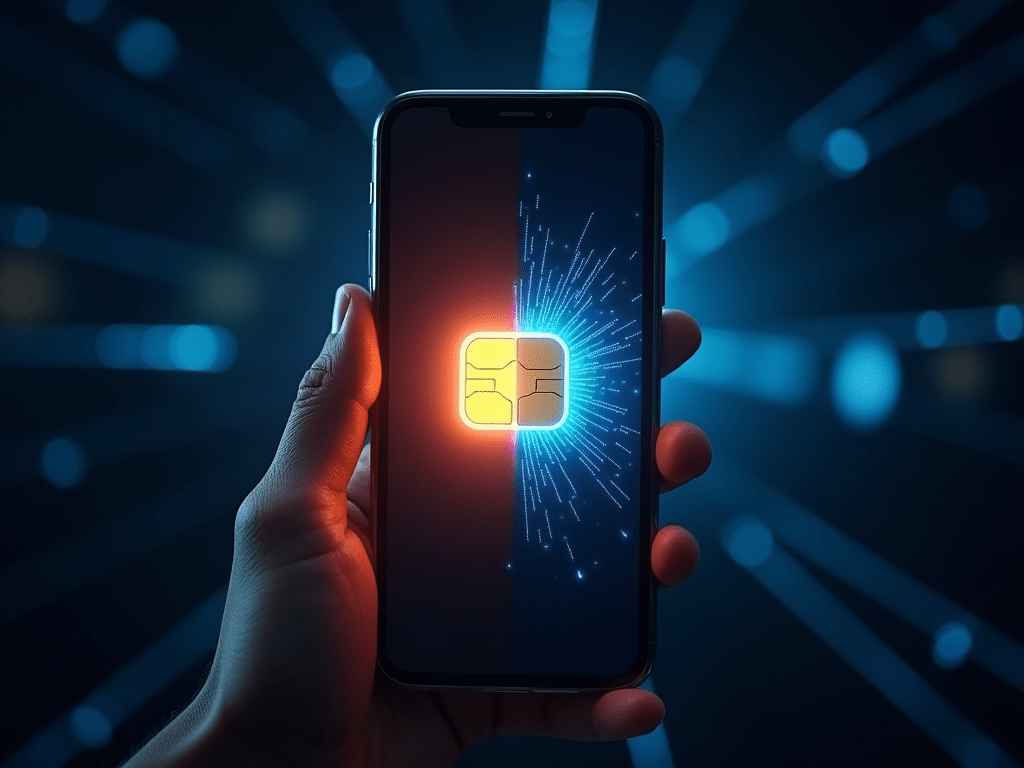Ever wondered what that tiny chip in your phone is all about? Well, buckle up, because we’re diving into the world of eSIMs! These little wonders are changing the game in mobile tech, and trust me, you’ll want to know all about them.
| Key Takeaways |
|---|
| eSIMs are embedded chips that replace physical SIM cards |
| They offer convenience, instant activation, and multiple profiles |
| eSIMs are ideal for travel and supported by many carriers |
| The technology is becoming more common in smartphones and IoT devices |

What in the World is an eSIM?
Alright, let’s break it down. An eSIM, or embedded SIM, is like a digital version of those plastic SIM cards we’ve been popping in and out of our phones for years. But here’s the kicker – it’s built right into your device! No more fumbling with tiny trays or losing that microscopic card.
Think of it as a chameleon for your phone. It can change carriers without you having to physically swap anything out. Pretty neat, huh?
Why eSIMs are the Bee’s Knees
Now, you might be wondering, “What’s the big deal?” Well, let me tell you, eSIMs are packing some serious perks:
- Convenience: Say goodbye to SIM card juggling acts!
- Instant Activation: Get connected faster than you can say “Wi-Fi password”
- Multiple Profiles: Work number, personal number, travel number – all in one device
- Space Saver: Slimmer phones? Yes, please!
ALso read: Lenme Reviews
Setting Up Your eSIM: Easy as Pie
Setting up an eSIM is a breeze. Here’s the lowdown:
- Check if your phone supports eSIM (most new models do)
- Contact your carrier or choose an eSIM plan
- Scan a QR code or use your carrier’s app
- Follow the on-screen prompts
- Voila! You’re connected
It’s so simple, even your grandma could do it. (No offense, Grandma!)
eSIM vs Physical SIM: The Showdown
Let’s pit these two against each other, shall we?
| Feature | eSIM | Physical SIM |
|---|---|---|
| Size | Embedded in device | Removable card |
| Activation | Remote | Physical insertion |
| Switching Plans | Quick and easy | Requires new card |
| Device Compatibility | Growing, but limited | Universal |
As you can see, eSIMs are giving traditional SIMs a run for their money. But don’t worry, physical SIMs aren’t going extinct just yet. Many phones now support both, giving you the best of both worlds.
The Traveler’s Best Friend
If you’re a globetrotter like me, eSIMs are about to become your new BFF. Picture this: you land in a new country, and instead of hunting down a local SIM card, you just download a new profile. Boom! You’re connected before you even leave the airport.
I remember the days of collecting SIM cards like postcards from every country I visited. Now, my phone’s as international as I am, without the clutter!
How to Set Up and Activate an eSIM

Alright, let’s get down to business. Setting up an eSIM might sound like rocket science, but trust me, it’s easier than programming your grandma’s VCR. (Remember those? No? Just me? Okay, moving on.)
Here’s the step-by-step lowdown:
- Check your device compatibility
- Contact your carrier or choose an eSIM plan
- Get your activation code or QR code
- Go to your phone’s settings
- Look for “Add Cellular Plan” or similar
- Scan the QR code or enter the activation code manually
- Follow the on-screen prompts
- Name your new plan (like “Work” or “Travel”)
- Choose which plan to use for calls, data, etc.
- Enjoy your newly activated eSIM!
Pro tip: Keep that QR code safe! You might need it if you ever need to reactivate your eSIM.
eSIM Support and Availability: Who’s In?
You might be wondering, “Can I jump on this eSIM bandwagon?” Well, let’s see who’s invited to the party:
Smartphone Models
- iPhones (iPhone XS and newer)
- Google Pixels (Pixel 2 and newer)
- Samsung Galaxy (S20 and newer)
- Many other Android phones
Carriers
Most major carriers are on board, but availability can vary by country. In the US, you’ve got:
- AT&T
- T-Mobile
- Verizon
And many others are joining the club. It’s like watching dominos fall – in a good way!
eSIM for Travel: Your Passport to Hassle-Free Roaming
Picture this: You’re in Paris, sipping coffee by the Eiffel Tower, when suddenly you need to make a call. With an eSIM, you’re just a few taps away from local rates. No more hunting for SIM cards or dealing with sky-high roaming fees. It’s like having a local phone number in your pocket, wherever you go!
Here’s why travelers are falling head over heels for eSIMs:
- Instant Activation: Land, download, connect. Simple as that.
- Multiple Plans: Keep your home number AND get a local line.
- Cost-Effective: Often cheaper than traditional roaming options.
- Flexibility: Switch between plans as you country-hop.
I remember the days of playing SIM card roulette at foreign airports. Now, I just download a new eSIM plan before I even board the plane. Talk about travel smart!
The Future of eSIM: Crystal Ball Time
Alright, let’s put on our futurist hats and take a peek at what’s coming down the eSIM pipeline:
- iSIM (Integrated SIM): Think eSIM, but even more integrated into your device’s chip.
- IoT Explosion: eSIMs are perfect for smart devices. Your fridge might soon have its own phone number!
- Bye-Bye Physical SIMs: We might see phones without SIM trays altogether.
- eSIM Marketplaces: Imagine an “app store” for cellular plans. Choose, download, connect!
The future’s looking bright, folks. And it’s got no SIM card slots!
eSIM vs Physical SIM: The Ultimate Showdown
Let’s settle this once and for all. Here’s how these two stack up:
| Feature | eSIM | Physical SIM |
|---|---|---|
| Size | Embedded in device | Removable card |
| Activation | Remote (minutes) | Physical insertion |
| Switching Plans | Quick and easy | Requires new card |
| Multiple Profiles | Yes | No (unless dual-SIM) |
| Device Compatibility | Growing, but limited | Universal |
| Durability | Can’t be lost or damaged | Can be lost or damaged |
As you can see, eSIMs are pulling ahead in many areas. But physical SIMs still have their place, especially in older devices or regions where eSIM tech hasn’t caught on yet.
Wrapping It Up: The eSIM Revolution
So there you have it, folks. eSIMs are more than just a cool new feature – they’re changing the game in mobile connectivity. Whether you’re a tech geek, a globetrotter, or just someone who hates fiddling with tiny plastic cards, eSIMs have something to offer.
eSIMs are the future, and the future is now. So why not give it a try? Your next adventure in connectivity is just a download away!
The Future of eSIM: What’s Next?
Alright, tech enthusiasts and future gazers, let’s put on our crystal ball glasses and peek into what’s coming down the eSIM pipeline. Trust me, it’s looking pretty exciting!
iSIM: The Next Big Thing
Remember how we thought eSIMs were small? Well, say hello to iSIM (Integrated SIM). It’s like eSIM’s overachieving little brother. Here’s the scoop:
- Even smaller than eSIMs
- Built directly into the device’s processor
- More secure and energy-efficient
Imagine a world where your smartwatch, fitness tracker, or even your smart glasses have cellular connectivity without adding any bulk. That’s the promise of iSIM technology.
IoT Revolution
The Internet of Things (IoT) is about to get a major boost from eSIM technology. We’re talking about:
- Smart cities with connected infrastructure
- Agricultural sensors for precision farming
- Tracking devices for logistics and supply chain
Soon, your fridge might be texting you to buy milk, and your car could be negotiating with parking meters. Welcome to the future, folks!
eSIM Adoption: By the Numbers
Let’s crunch some numbers, shall we? The eSIM market is exploding faster than a microwave popcorn bag:
| Year | Projected eSIM Devices |
|---|---|
| 2021 | 1.2 billion |
| 2025 | 3.4 billion |
| 2030 | 6.0 billion |
That’s a whole lot of connected devices!
Overcoming Challenges: It’s Not All Smooth Sailing
Now, I know what you’re thinking. “This all sounds great, but what’s the catch?” Well, like any new tech, eSIMs face some hurdles:
- Limited Device Support: Not all phones support eSIMs yet.
- Carrier Resistance: Some carriers are slow to adopt eSIM technology.
- Consumer Education: Many people don’t know about eSIMs or how to use them.
- Security Concerns: As with any digital technology, security is an ongoing challenge.
But don’t worry! These are speed bumps, not roadblocks. The tech world is working hard to address these issues.
Tips for Making the Most of Your eSIM
Ready to jump on the eSIM bandwagon? Here are some pro tips to get you started:
- Check Compatibility: Make sure your device supports eSIM before getting too excited.
- Compare Plans: Shop around for the best eSIM plans, especially for travel.
- Keep Your QR Code: Save it somewhere safe in case you need to reactivate.
- Use Dual SIM Features: Many phones let you use a physical SIM and eSIM together.
- Stay Updated: Keep your device’s software up to date for the best eSIM performance.
The Environmental Impact: eSIMs Go Green
Here’s a cool fact: eSIMs are actually helping the environment! How, you ask?
- Less Plastic Waste: No more tiny plastic SIM cards ending up in landfills.
- Reduced Shipping: No need to mail physical SIM cards around the world.
- Energy Efficiency: eSIMs can help devices manage power more effectively.
So, by embracing eSIM technology, you’re not just being tech-savvy – you’re also being eco-friendly. Go you!
Conclusion: Embracing the eSIM Era
As we wrap up our deep dive into the world of eSIMs, one thing is clear: this tiny technology is making a big impact. From simplifying our daily lives to revolutionizing how we stay connected while traveling, eSIMs are changing the game.
Sure, there are challenges to overcome and kinks to iron out. But that’s true of any groundbreaking technology. Remember when we thought carrying around a discman was the height of portable music? Yeah, times change fast in the tech world.
So, whether you’re a tech enthusiast, a frequent traveler, or just someone who likes the idea of a slimmer phone (who doesn’t?), eSIM technology has something to offer you. It’s not just the future of mobile connectivity – it’s increasingly becoming the present.






